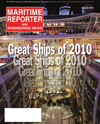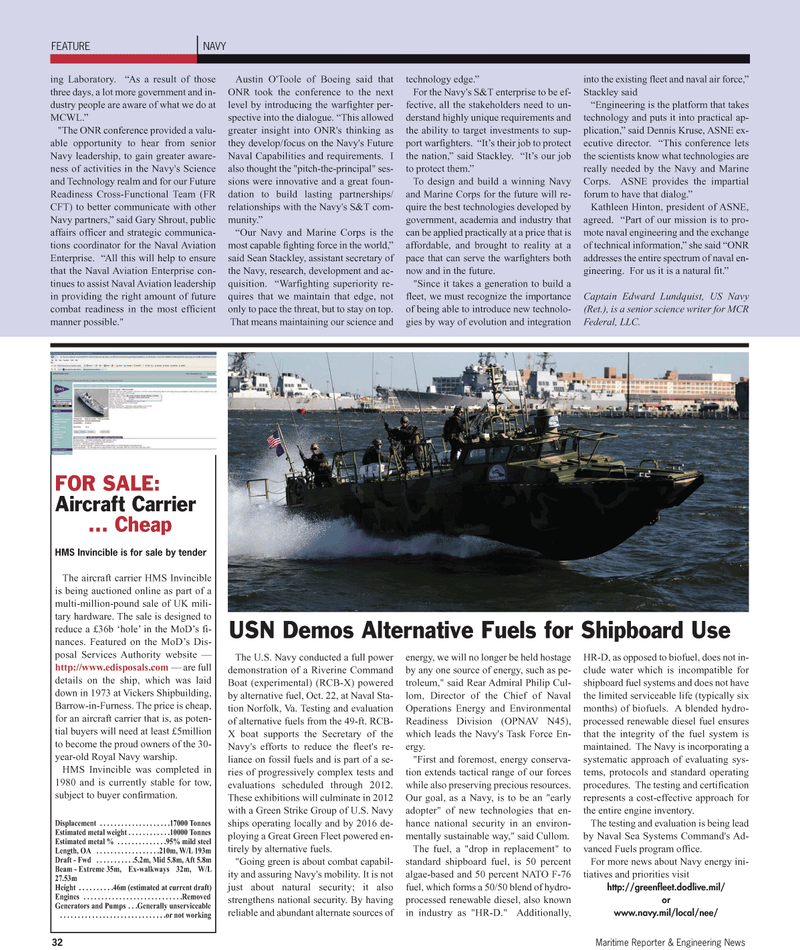
Page 32: of Maritime Reporter Magazine (December 2010)
Great Ships of 2010
Read this page in Pdf, Flash or Html5 edition of December 2010 Maritime Reporter Magazine
32 Maritime Reporter & Engineering News ing Laboratory. “As a result of those three days, a lot more government and in- dustry people are aware of what we do at
MCWL.” "The ONR conference provided a valu- able opportunity to hear from senior
Navy leadership, to gain greater aware- ness of activities in the Navy's Science and Technology realm and for our Future
Readiness Cross-Functional Team (FR
CFT) to better communicate with other
Navy partners,” said Gary Shrout, public affairs officer and strategic communica- tions coordinator for the Naval Aviation
Enterprise. “All this will help to ensure that the Naval Aviation Enterprise con- tinues to assist Naval Aviation leadership in providing the right amount of future combat readiness in the most efficient manner possible."
Austin O'Toole of Boeing said that
ONR took the conference to the next level by introducing the warfighter per- spective into the dialogue. “This allowed greater insight into ONR's thinking as they develop/focus on the Navy's Future
Naval Capabilities and requirements. I also thought the "pitch-the-principal" ses- sions were innovative and a great foun- dation to build lasting partnerships/ relationships with the Navy's S&T com- munity.” “Our Navy and Marine Corps is the most capable fighting force in the world,” said Sean Stackley, assistant secretary of the Navy, research, development and ac- quisition. “Warfighting superiority re- quires that we maintain that edge, not only to pace the threat, but to stay on top.
That means maintaining our science and technology edge.”
For the Navy's S&T enterprise to be ef- fective, all the stakeholders need to un- derstand highly unique requirements and the ability to target investments to sup- port warfighters. “It’s their job to protect the nation,” said Stackley. “It’s our job to protect them.”
To design and build a winning Navy and Marine Corps for the future will re- quire the best technologies developed by government, academia and industry that can be applied practically at a price that is affordable, and brought to reality at a pace that can serve the warfighters both now and in the future. "Since it takes a generation to build a fleet, we must recognize the importance of being able to introduce new technolo- gies by way of evolution and integration into the existing fleet and naval air force,”
Stackley said “Engineering is the platform that takes technology and puts it into practical ap- plication,” said Dennis Kruse, ASNE ex- ecutive director. “This conference lets the scientists know what technologies are really needed by the Navy and Marine
Corps. ASNE provides the impartial forum to have that dialog.”
Kathleen Hinton, president of ASNE, agreed. “Part of our mission is to pro- mote naval engineering and the exchange of technical information,” she said “ONR addresses the entire spectrum of naval en- gineering. For us it is a natural fit.”
Captain Edward Lundquist, US Navy (Ret.), is a senior science writer for MCR
Federal, LLC.
FEATURE NAVY
FOR SALE:
Aircraft Carrier ... Cheap
HMS Invincible is for sale by tender
The aircraft carrier HMS Invincible is being auctioned online as part of a multi-million-pound sale of UK mili- tary hardware. The sale is designed to reduce a £36b ‘hole’ in the MoD’s fi- nances. Featured on the MoD’s Dis- posal Services Authority website — http://www.edisposals.com — are full details on the ship, which was laid down in 1973 at Vickers Shipbuilding,
Barrow-in-Furness. The price is cheap, for an aircraft carrier that is, as poten- tial buyers will need at least £5million to become the proud owners of the 30- year-old Royal Navy warship.
HMS Invincible was completed in 1980 and is currently stable for tow, subject to buyer confirmation.
Displacement . . . . . . . . . . . . . . . . . . . .17000 Tonnes
Estimated metal weight . . . . . . . . . . . .10000 Tonnes
Estimated metal % . . . . . . . . . . . . . .95% mild steel
Length, OA . . . . . . . . . . . . . . . . . .210m, W/L 193m
Draft - Fwd . . . . . . . . . . .5.2m, Mid 5.8m, Aft 5.8m
Beam - Extreme 35m, Ex-walkways 32m, W/L 27.53m
Height . . . . . . . . . .46m (estimated at current draft)
Engines . . . . . . . . . . . . . . . . . . . . . . . . . . . .Removed
Generators and Pumps . . .Generally unserviceable . . . . . . . . . . . . . . . . . . . . . . . . . . . . . .or not working
The U.S. Navy conducted a full power demonstration of a Riverine Command
Boat (experimental) (RCB-X) powered by alternative fuel, Oct. 22, at Naval Sta- tion Norfolk, Va. Testing and evaluation of alternative fuels from the 49-ft. RCB-
X boat supports the Secretary of the
Navy's efforts to reduce the fleet's re- liance on fossil fuels and is part of a se- ries of progressively complex tests and evaluations scheduled through 2012.
These exhibitions will culminate in 2012 with a Green Strike Group of U.S. Navy ships operating locally and by 2016 de- ploying a Great Green Fleet powered en- tirely by alternative fuels. "Going green is about combat capabil- ity and assuring Navy's mobility. It is not just about natural security; it also strengthens national security. By having reliable and abundant alternate sources of energy, we will no longer be held hostage by any one source of energy, such as pe- troleum," said Rear Admiral Philip Cul- lom, Director of the Chief of Naval
Operations Energy and Environmental
Readiness Division (OPNAV N45), which leads the Navy's Task Force En- ergy. "First and foremost, energy conserva- tion extends tactical range of our forces while also preserving precious resources.
Our goal, as a Navy, is to be an "early adopter" of new technologies that en- hance national security in an environ- mentally sustainable way," said Cullom.
The fuel, a "drop in replacement" to standard shipboard fuel, is 50 percent algae-based and 50 percent NATO F-76 fuel, which forms a 50/50 blend of hydro- processed renewable diesel, also known in industry as "HR-D." Additionally,
HR-D, as opposed to biofuel, does not in- clude water which is incompatible for shipboard fuel systems and does not have the limited serviceable life (typically six months) of biofuels. A blended hydro- processed renewable diesel fuel ensures that the integrity of the fuel system is maintained. The Navy is incorporating a systematic approach of evaluating sys- tems, protocols and standard operating procedures. The testing and certification represents a cost-effective approach for the entire engine inventory.
The testing and evaluation is being lead by Naval Sea Systems Command's Ad- vanced Fuels program office.
For more news about Navy energy ini- tiatives and priorities visit http://greenfleet.dodlive.mil/ or www.navy.mil/local/nee/
USN Demos Alternative Fuels for Shipboard Use

 31
31

 33
33
